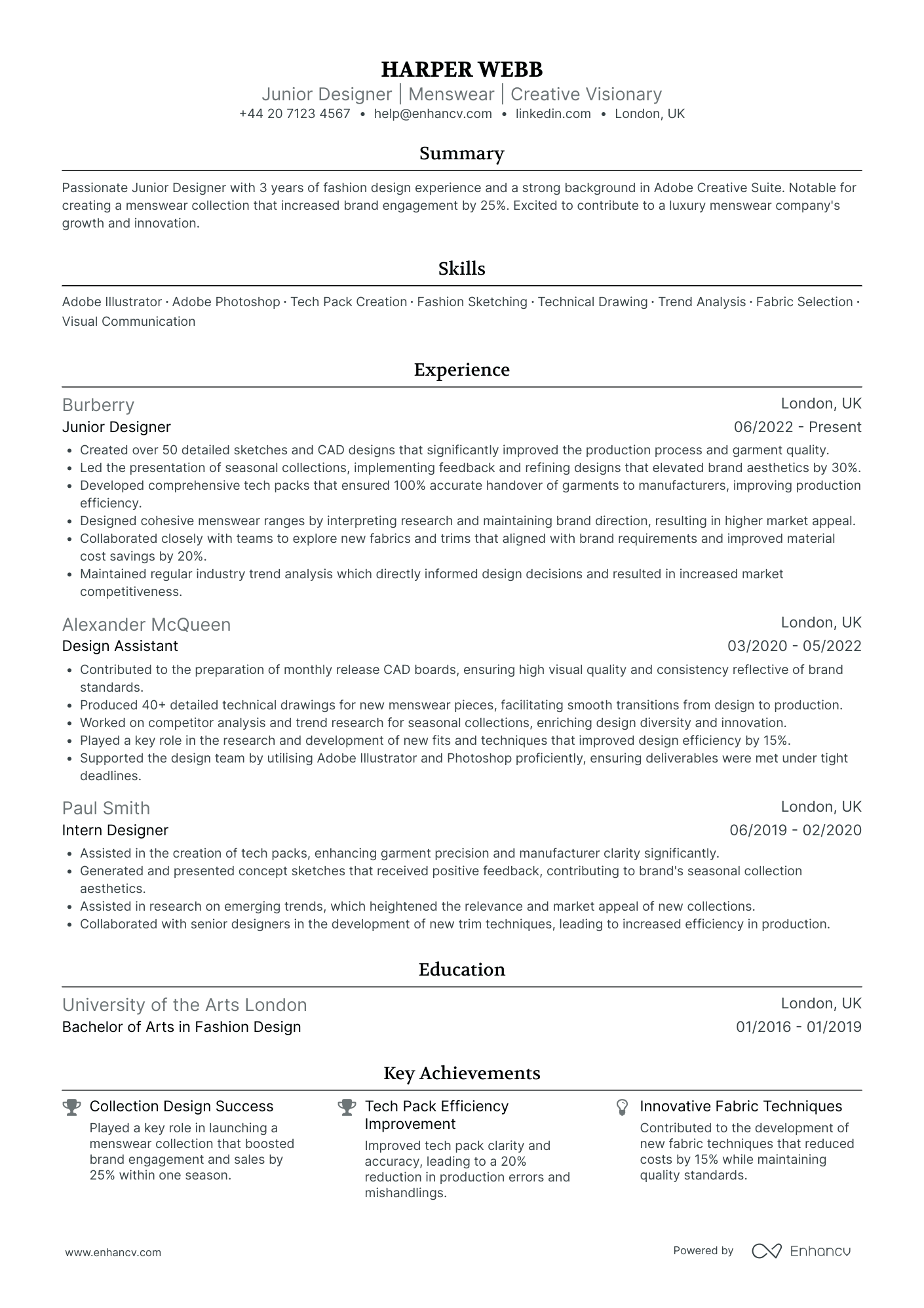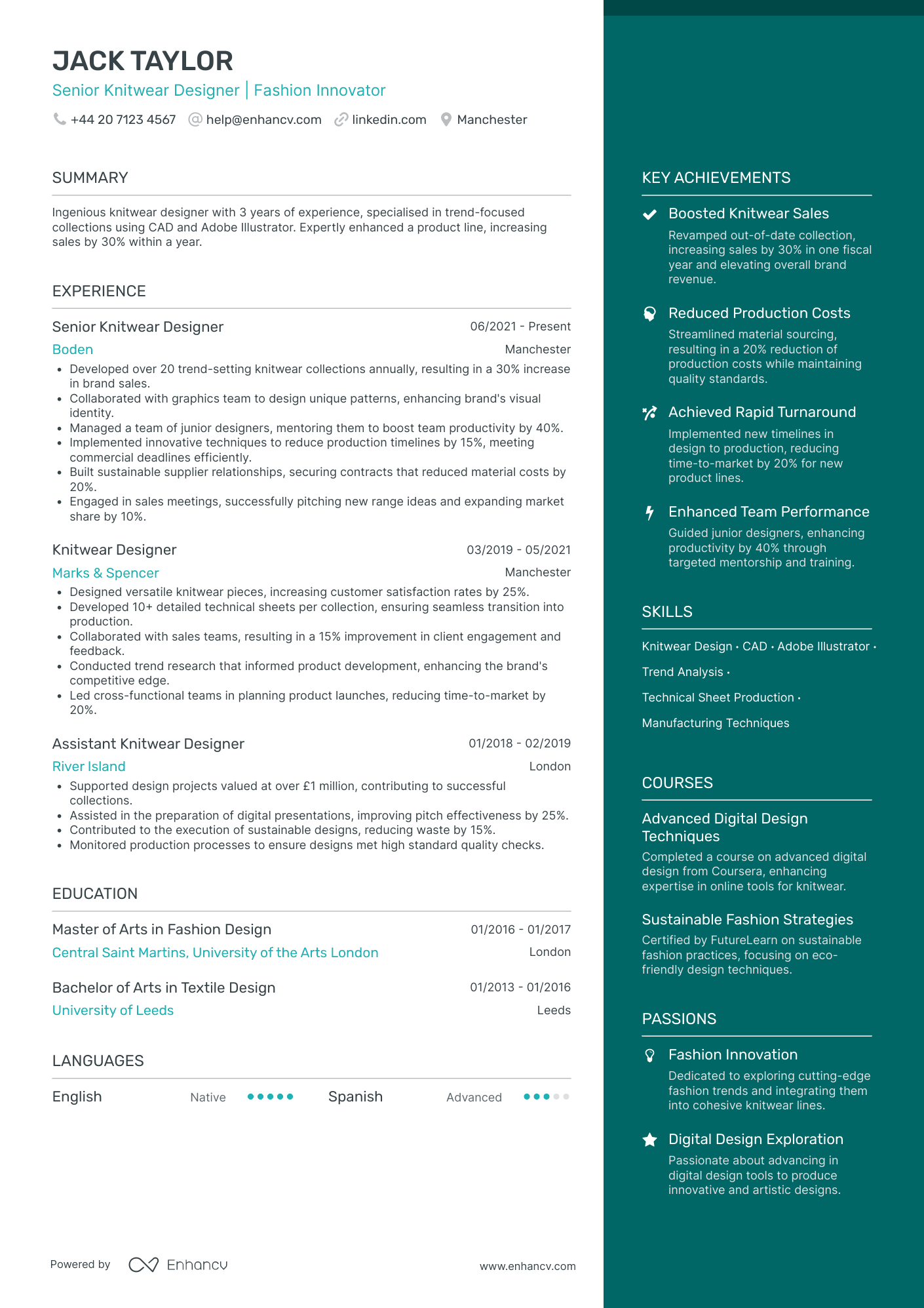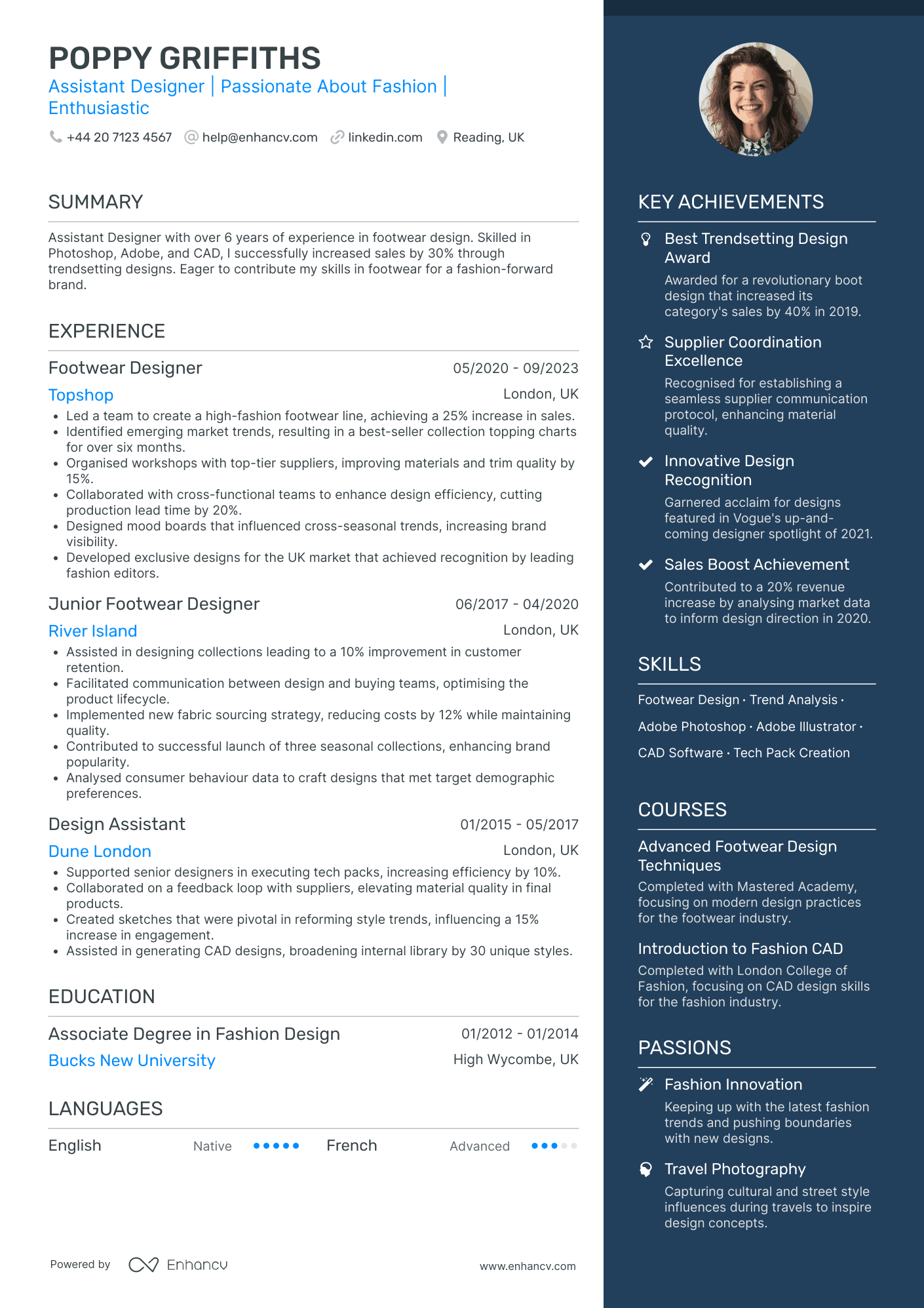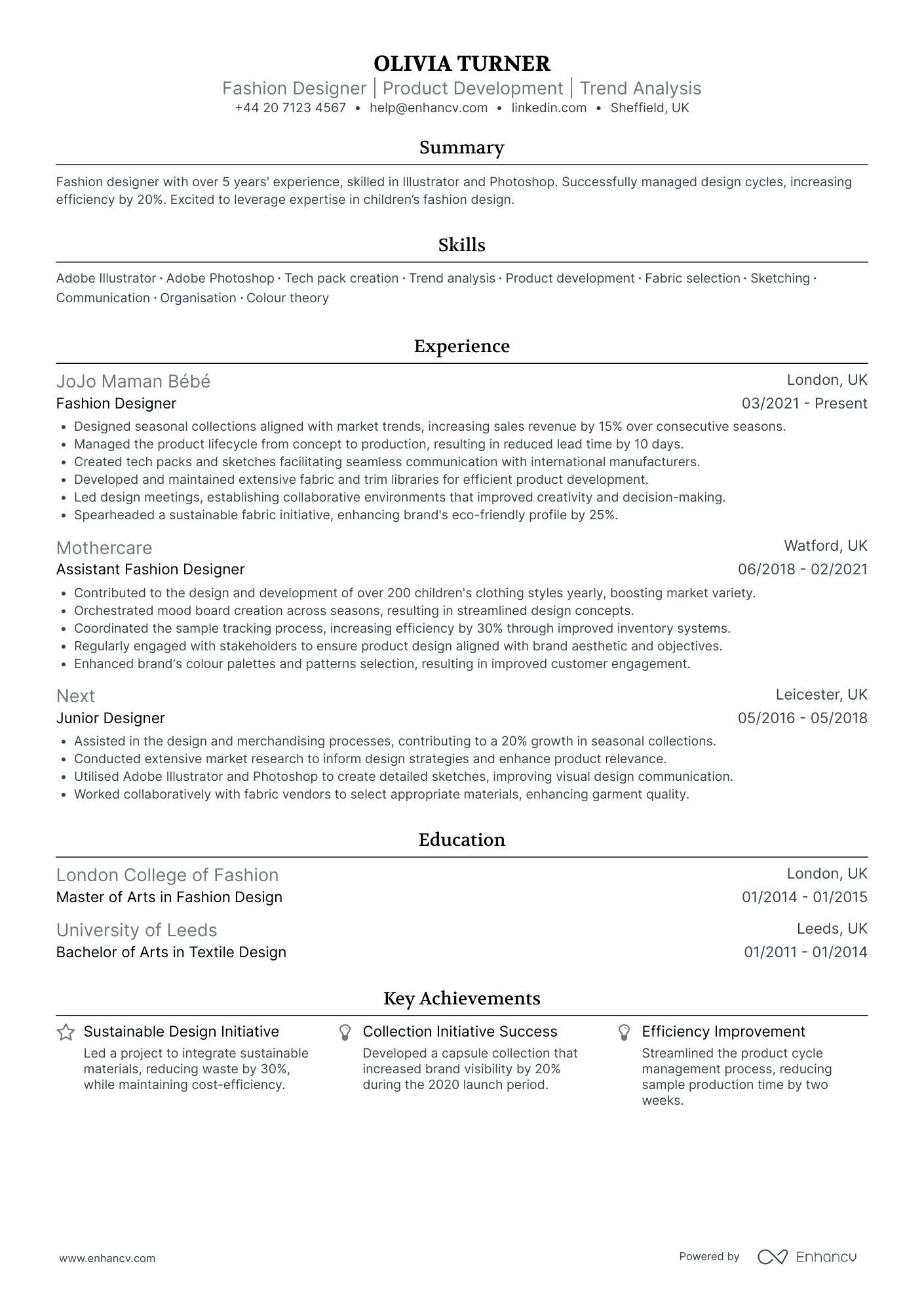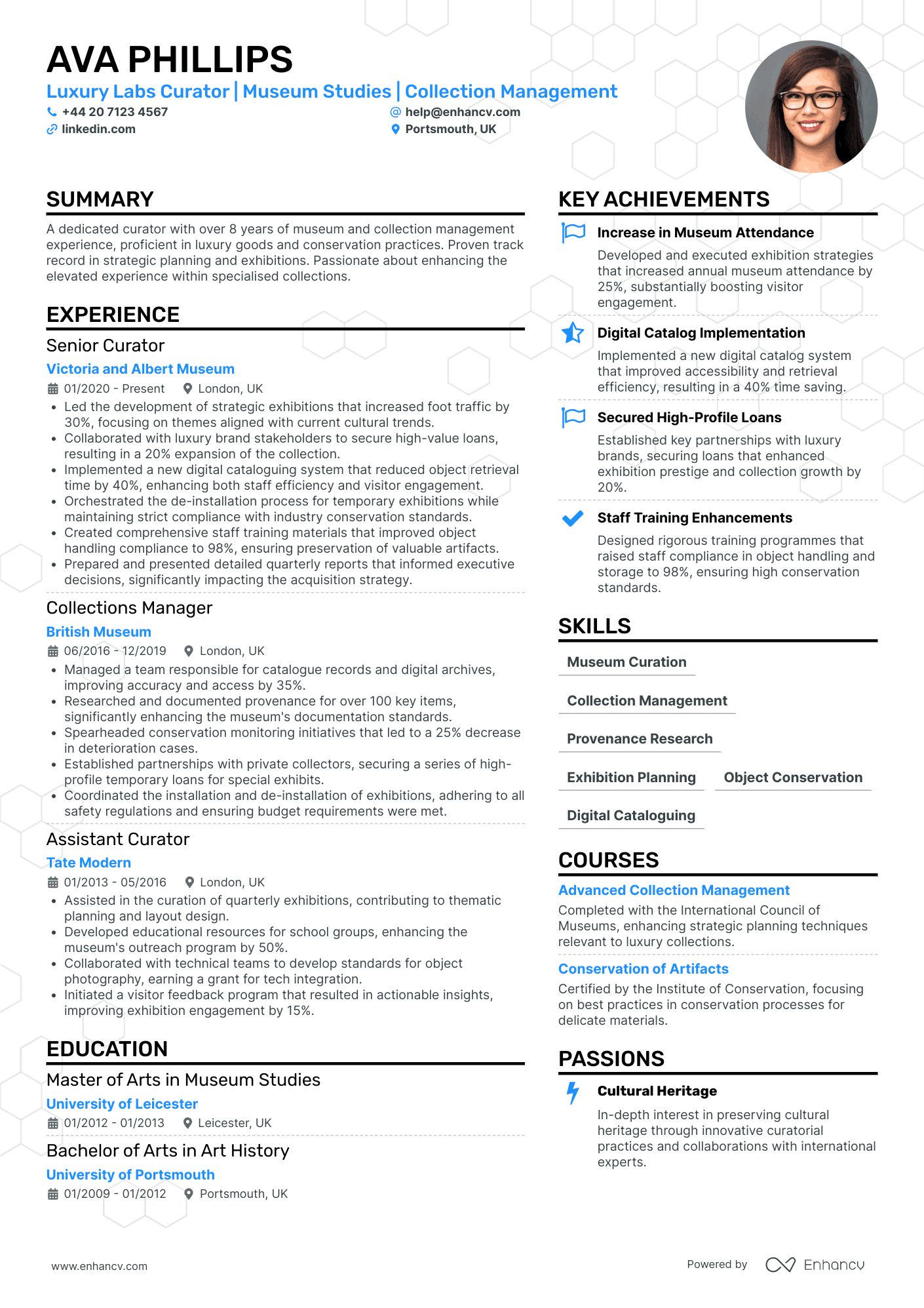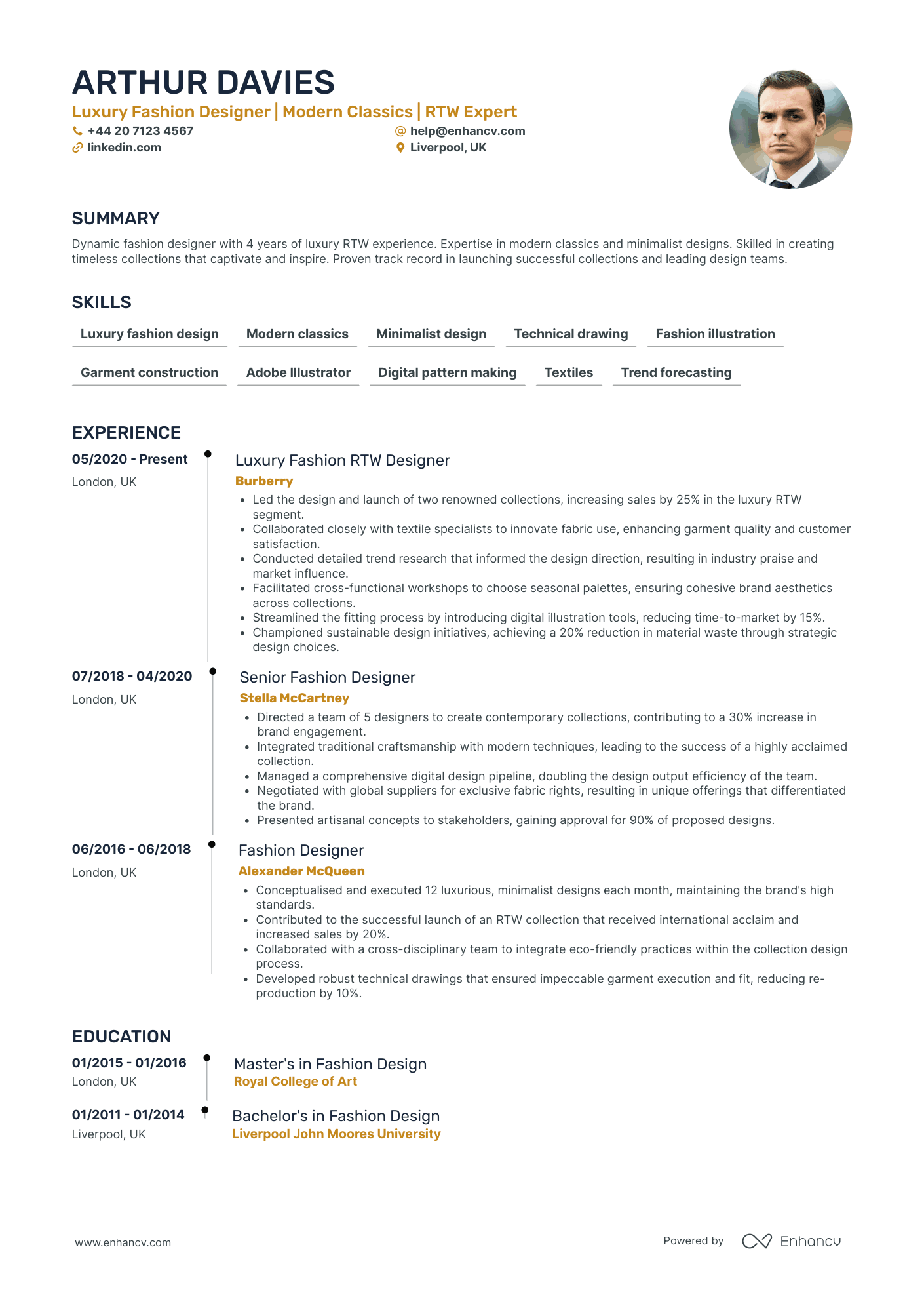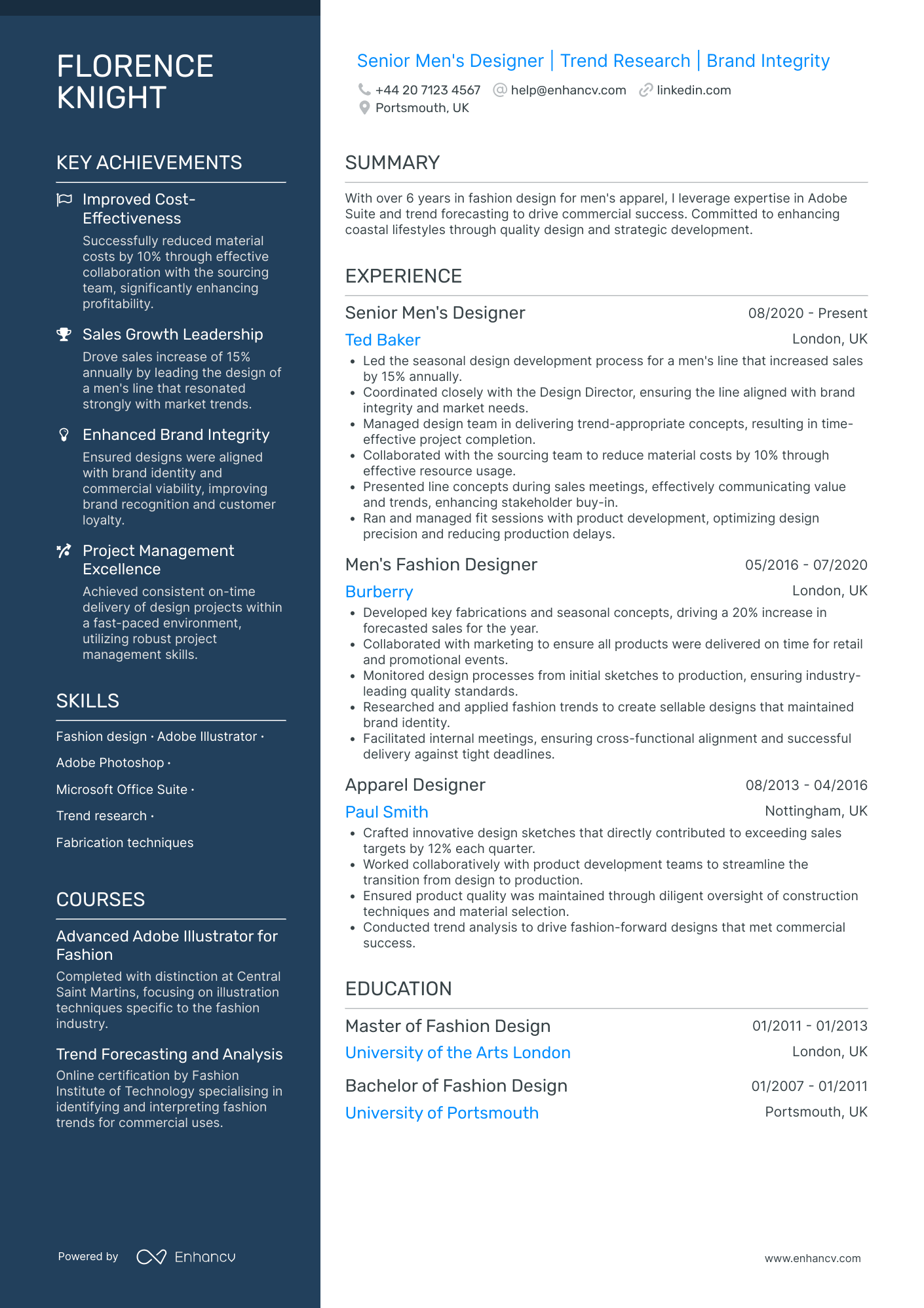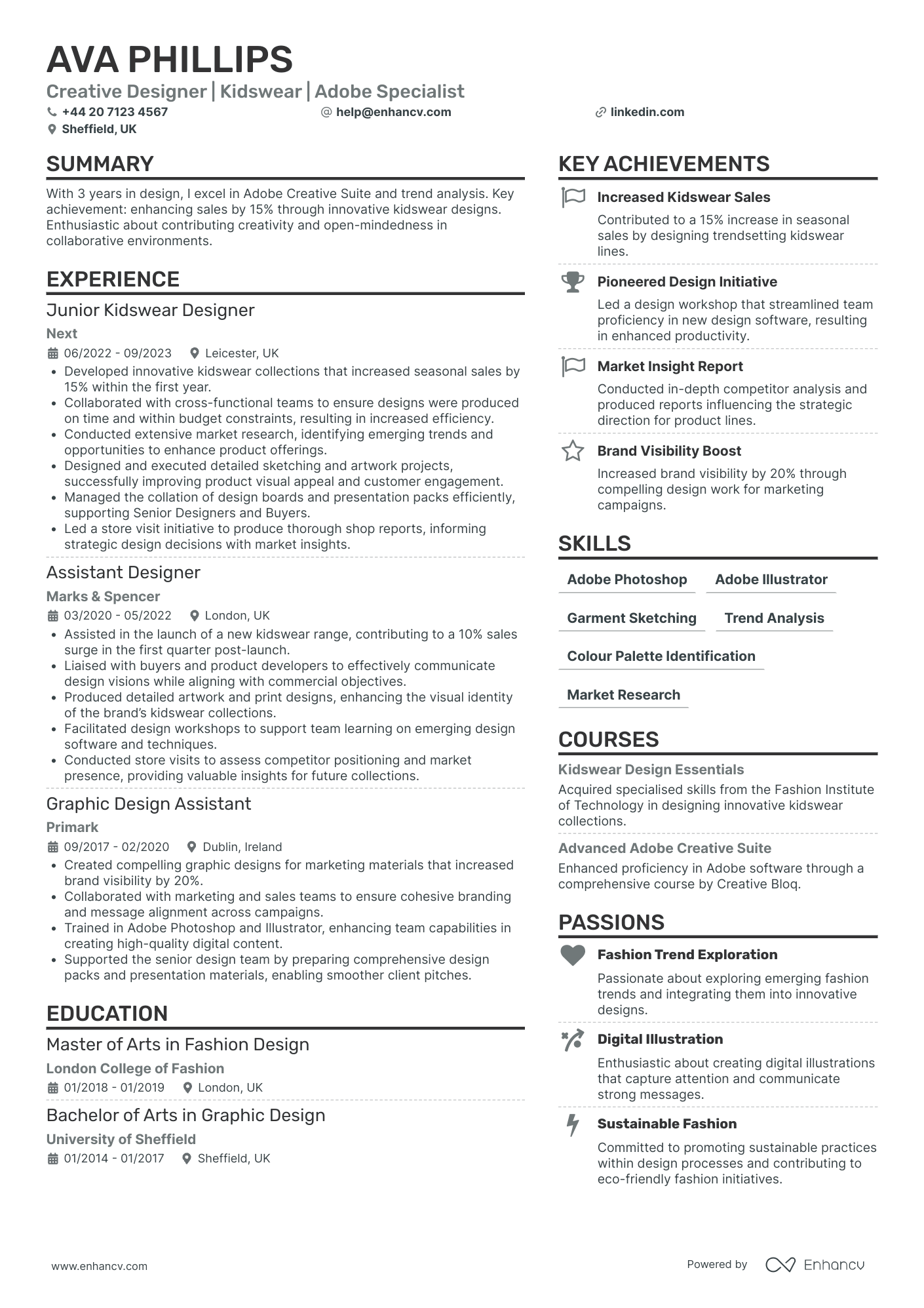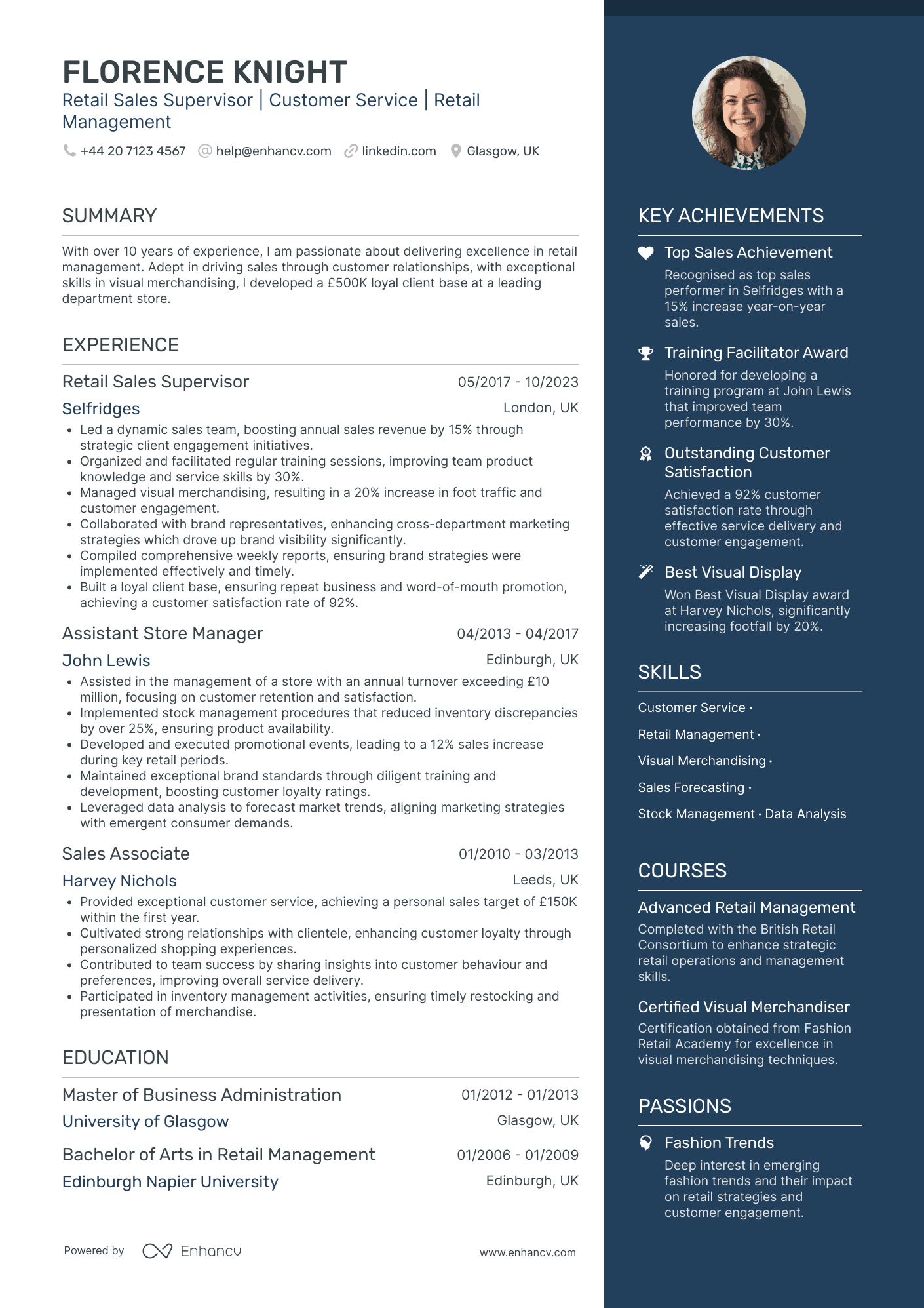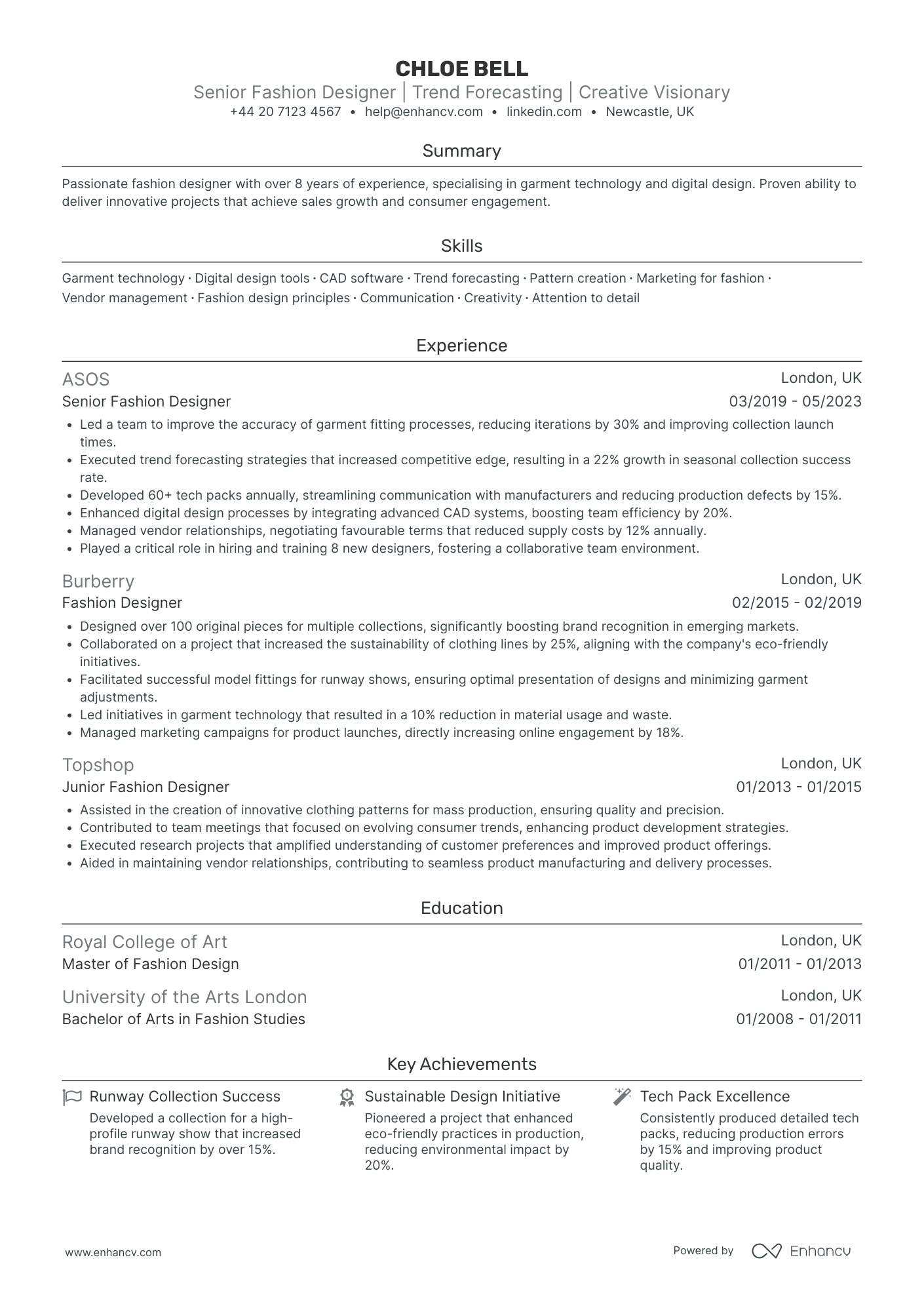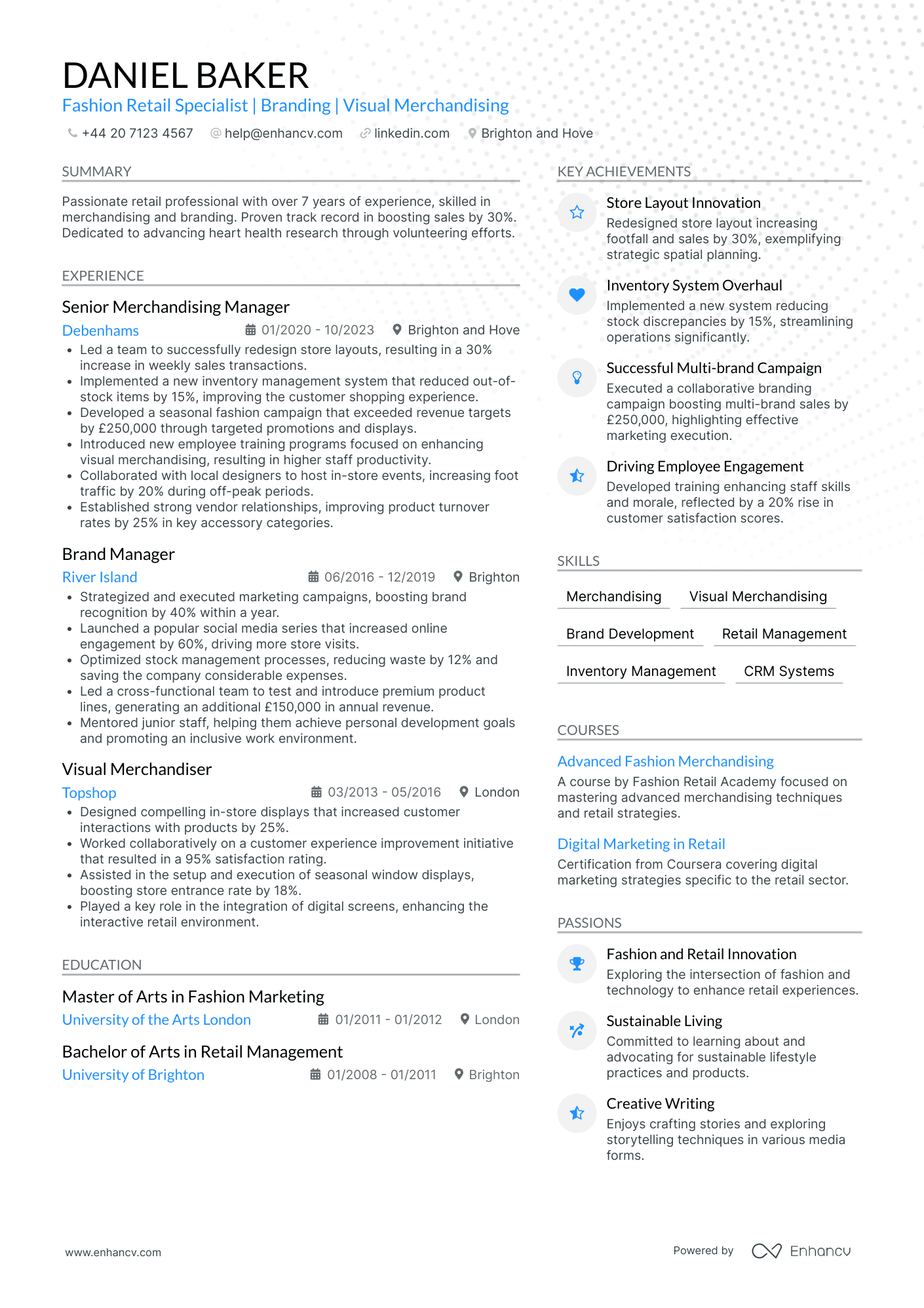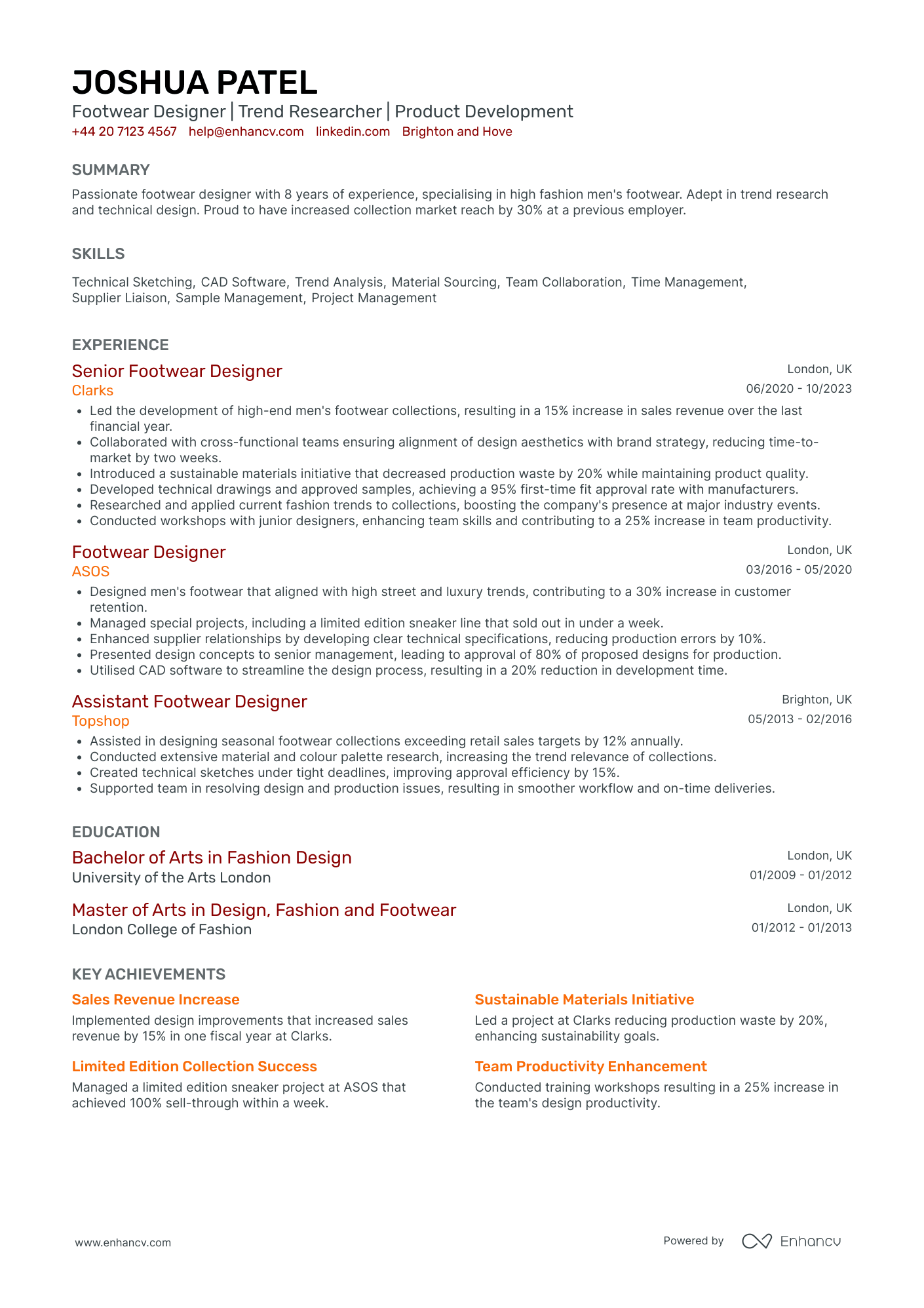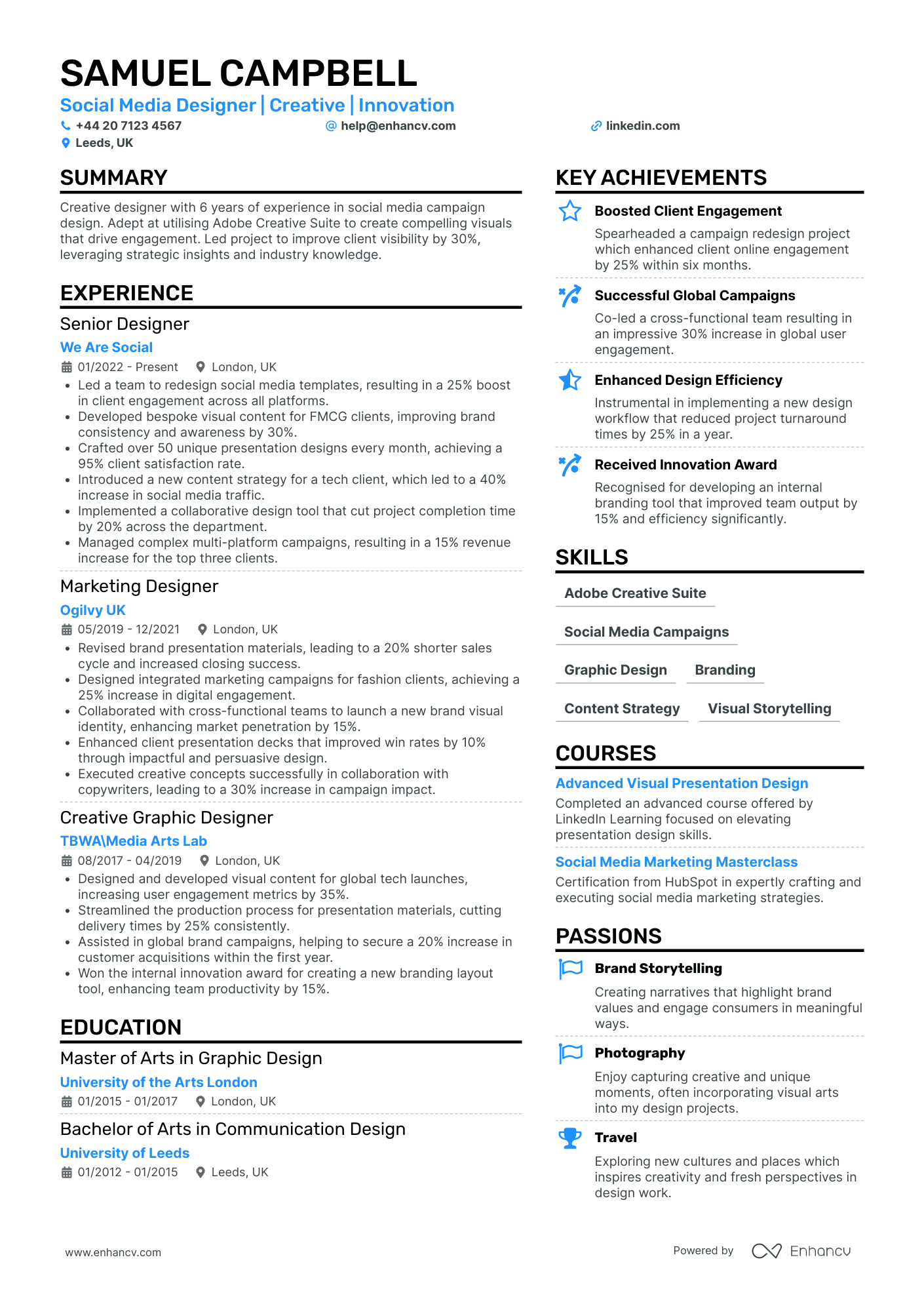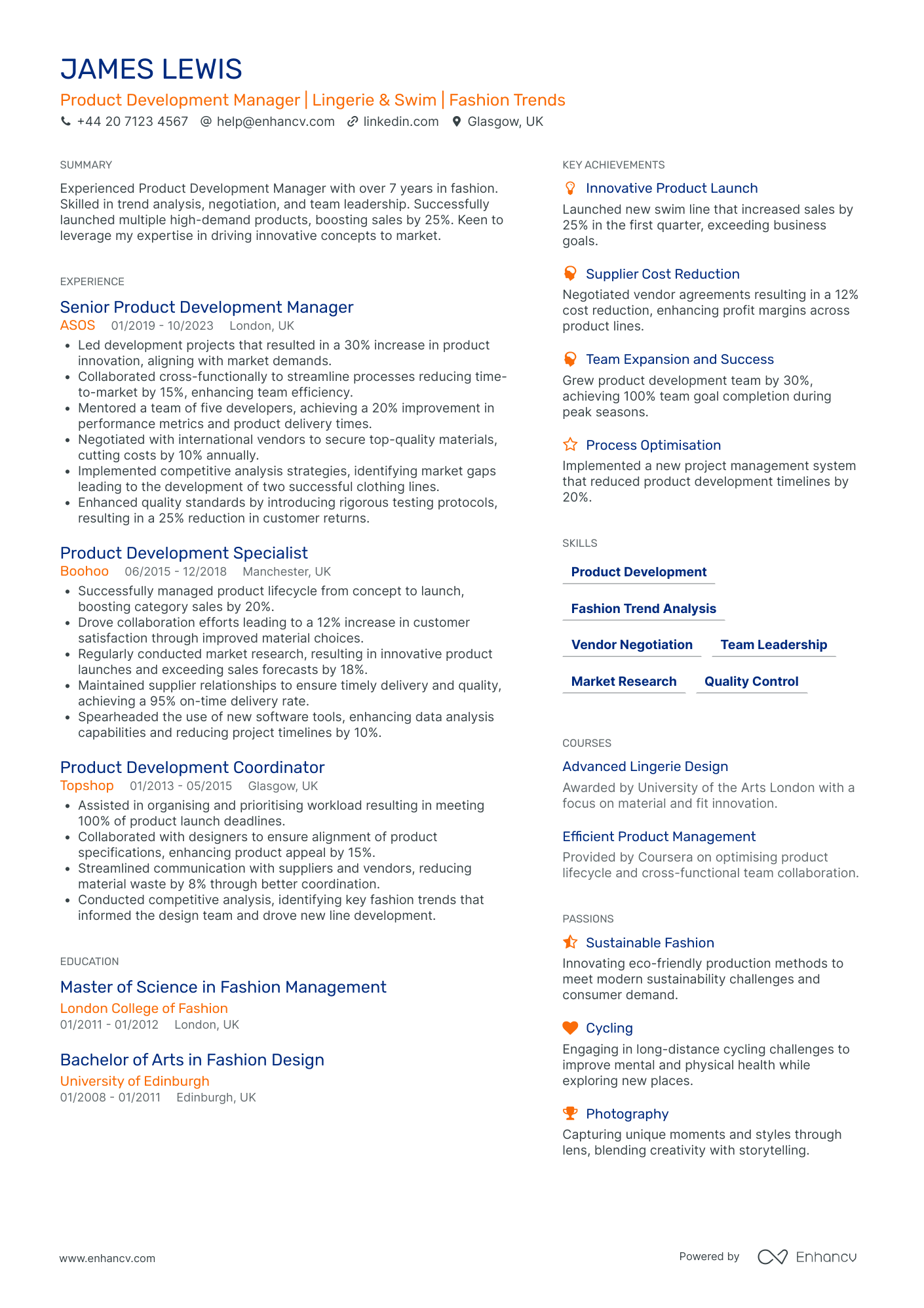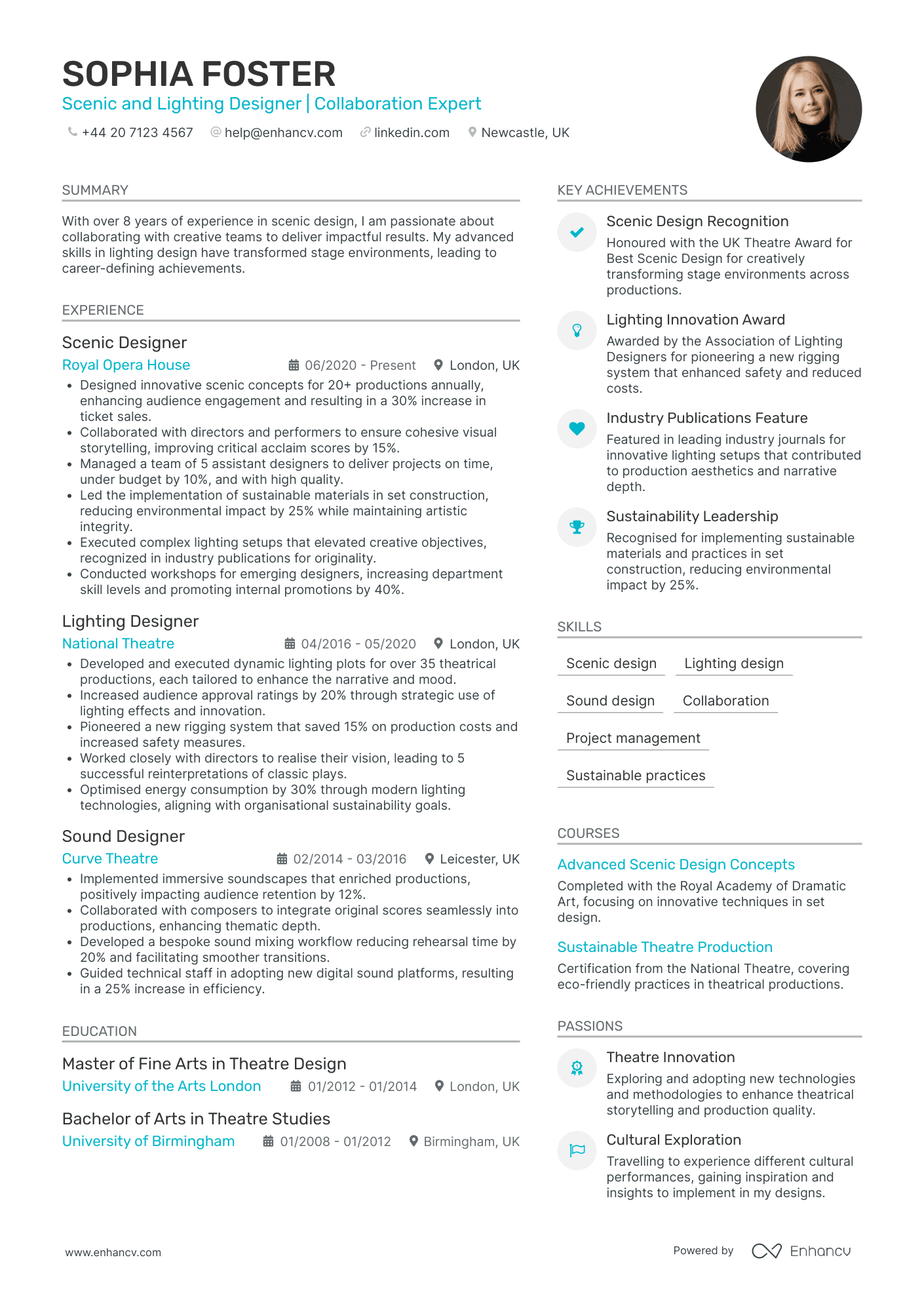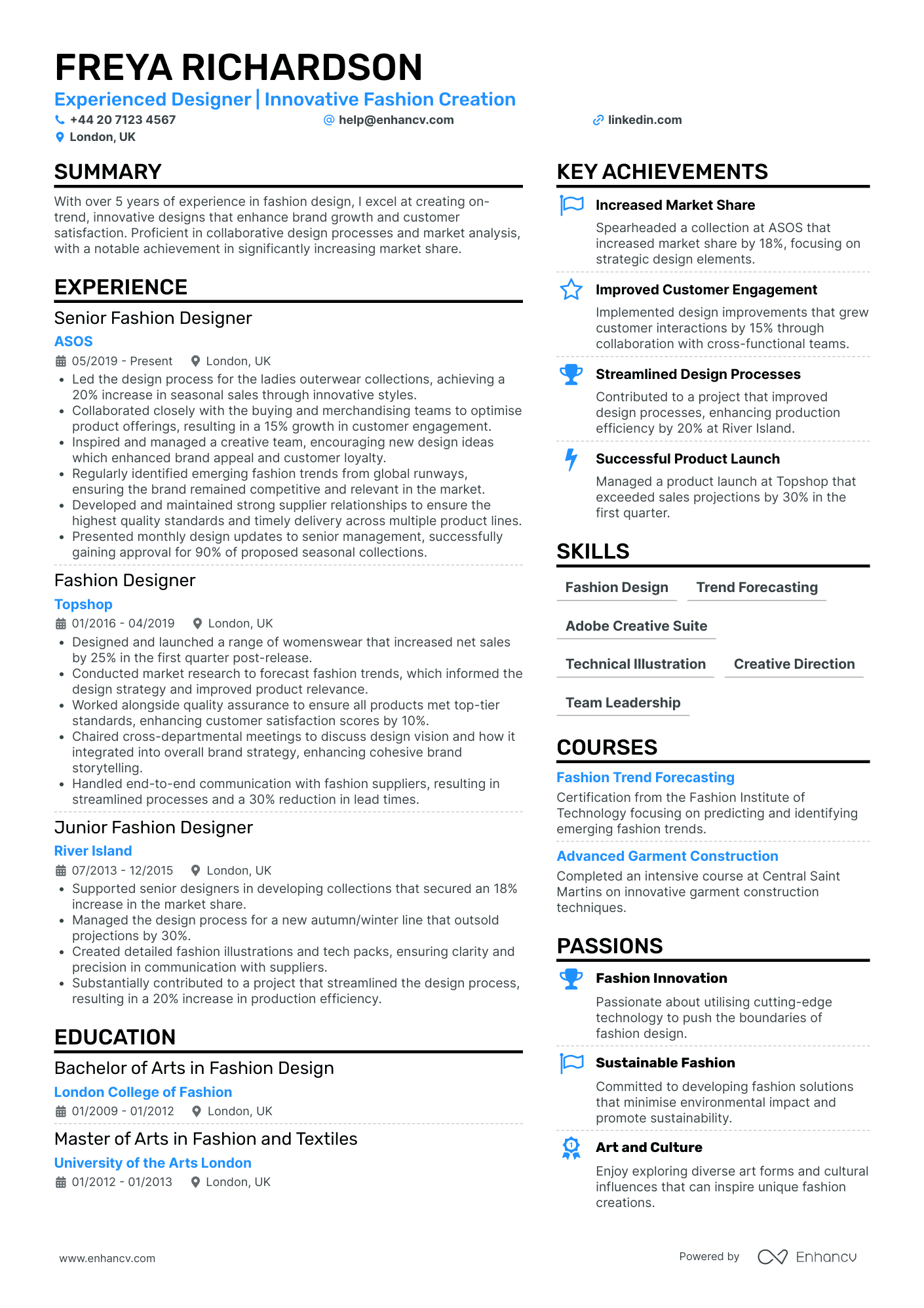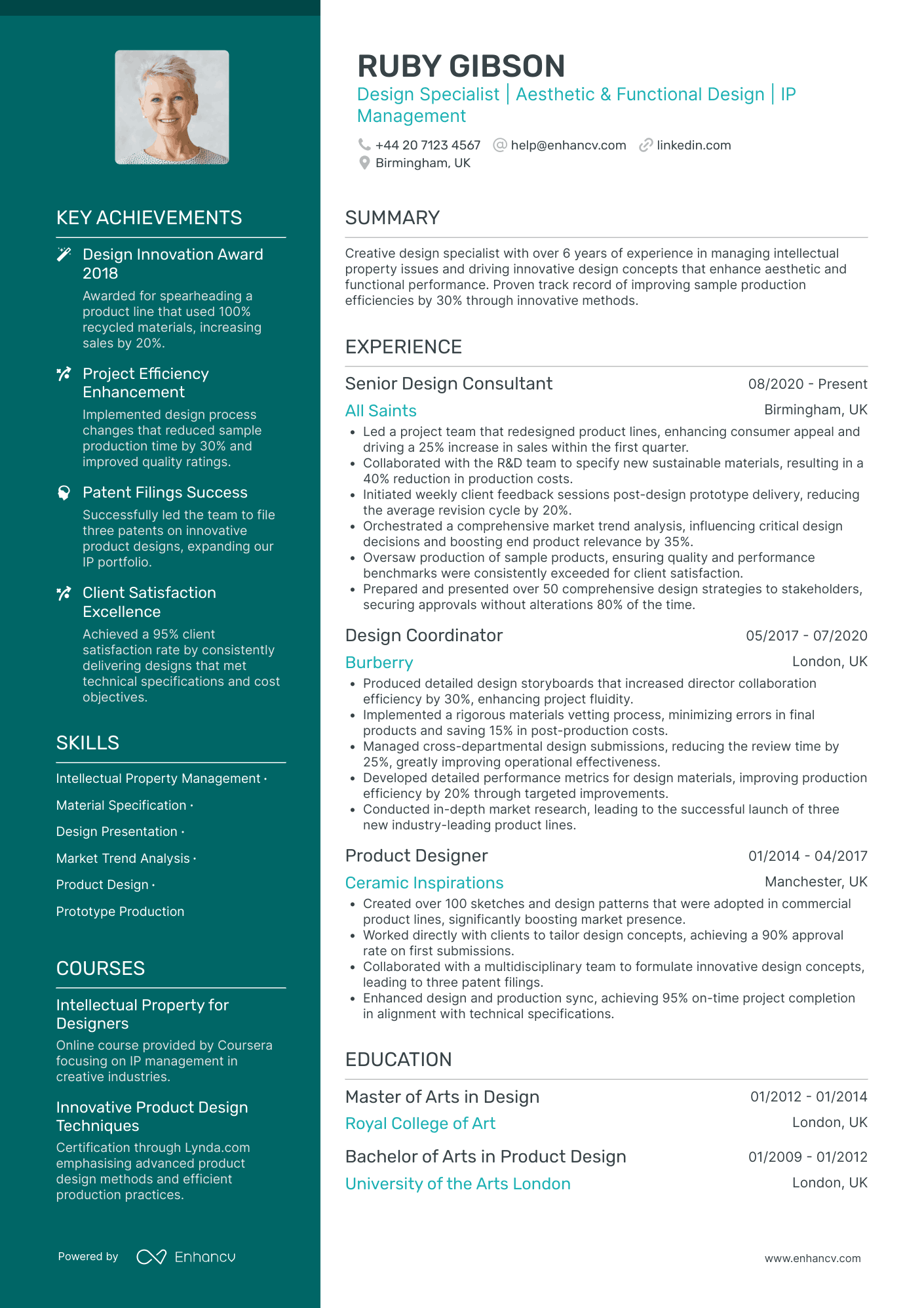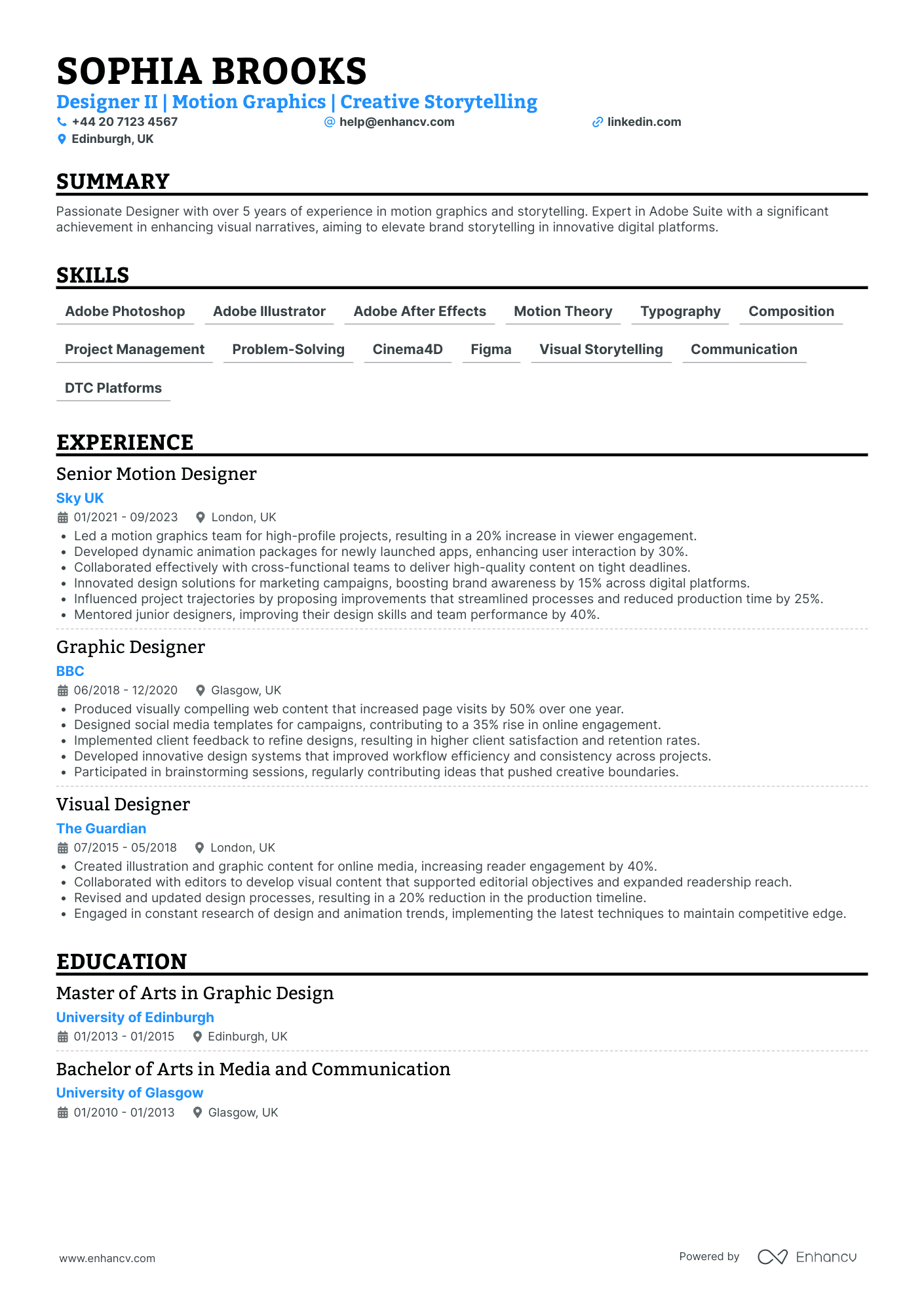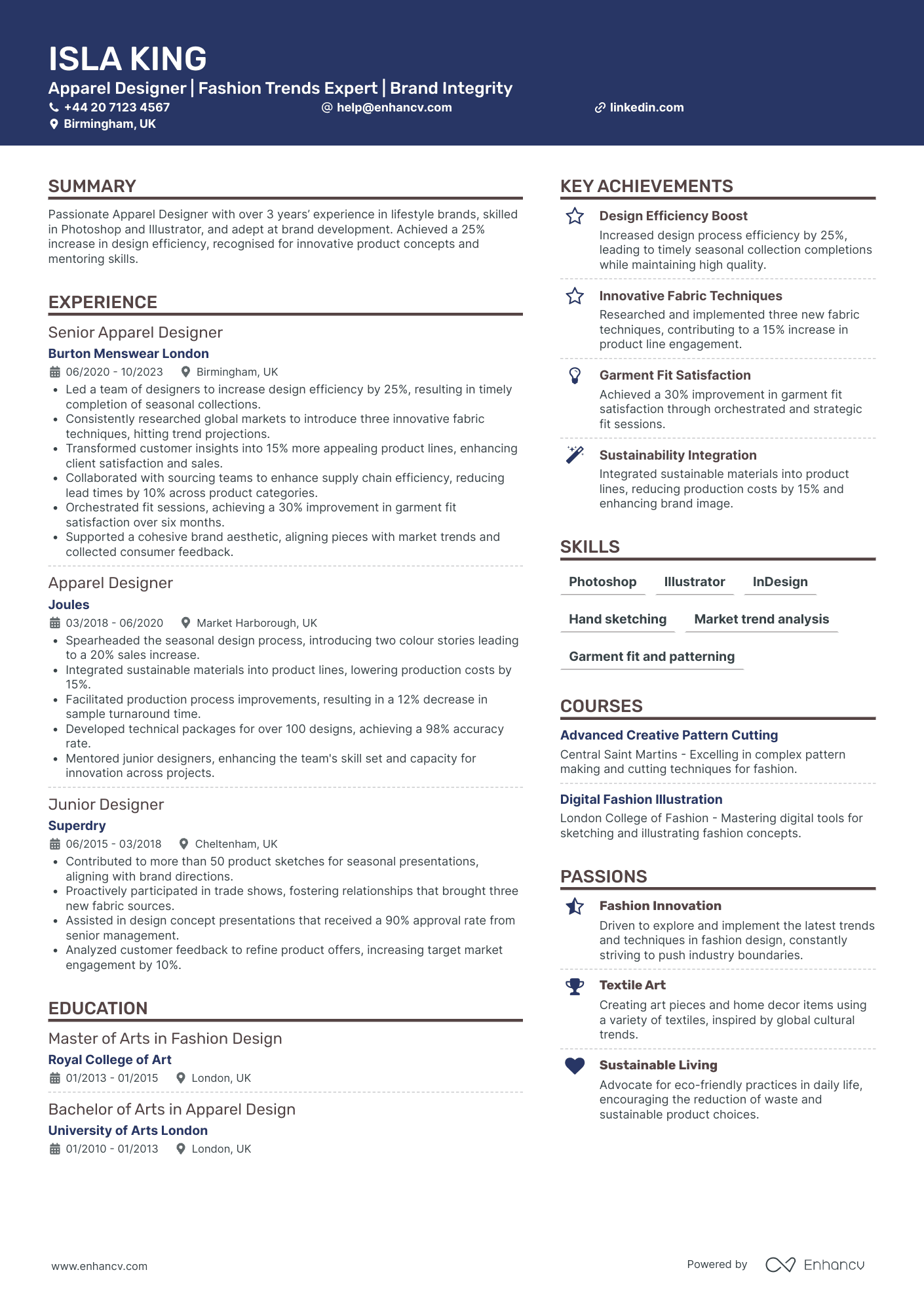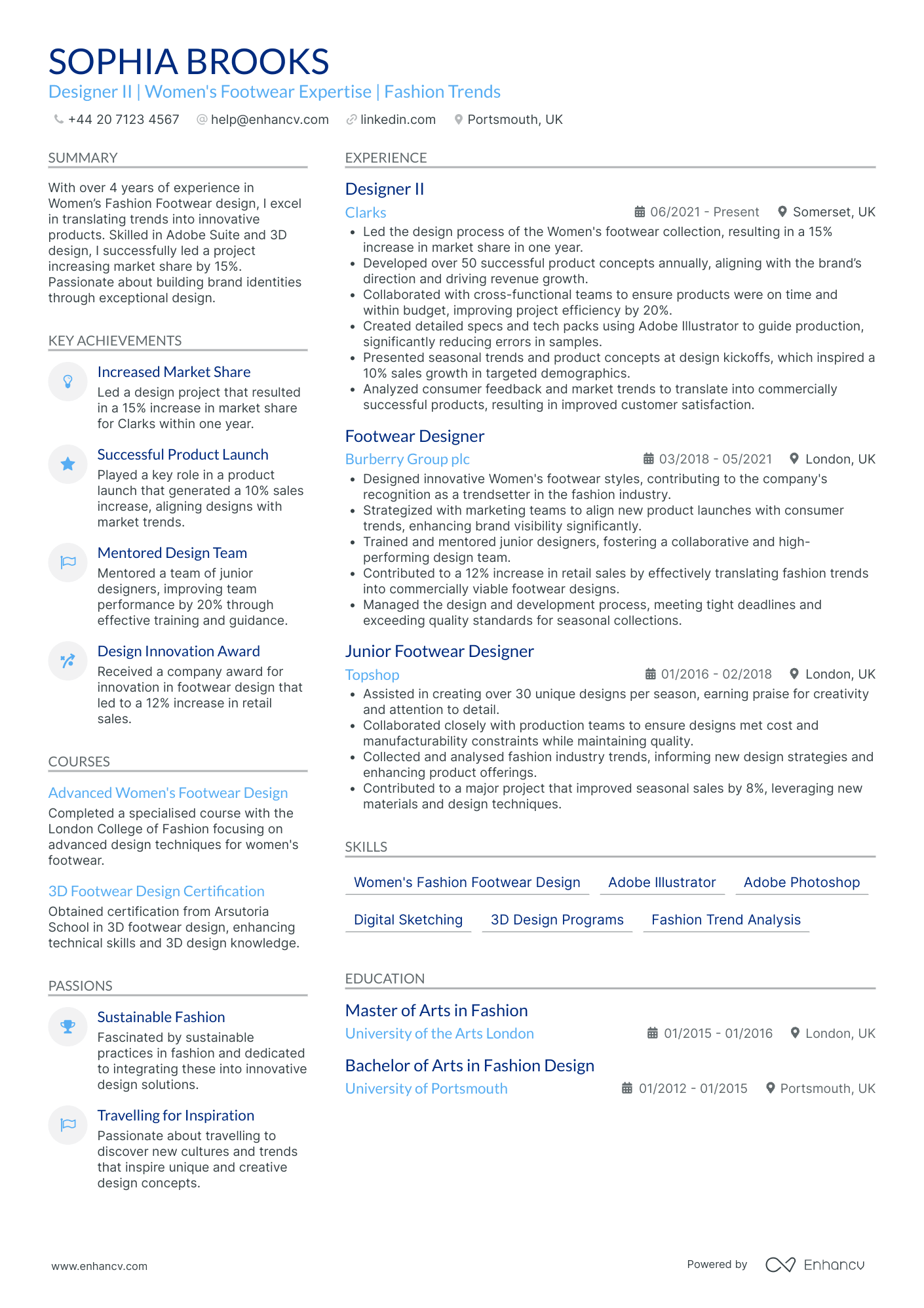One significant CV challenge you might encounter is showcasing your diverse range of skills and creative projects in a concise and compelling manner. Our guide offers tailored advice on how to highlight your most impressive achievements and construct a narrative that captures the essence of your unique design ethos.
- Applying best practices from real-world examples to ensure your profile always meets recruiters' expectations;
- What to include in your work experience section, apart from your past roles and responsibilities?
- Why are both hard and soft skills important for your application?
- How do you need to format your CV to pass the Applicant Tracker Software (ATS) assessment?
If you're writing your CV for a niche fashion designer role, make sure to get some inspiration from professionals:
CV examples for fashion designer
By Experience
Junior Fashion Designer
- Concise and Comprehensive Structure - The CV is efficiently structured, presenting all relevant information about Harper Webb’s career in a clear and concise manner. Key sections such as experience, education, skills, and achievements are organized to allow easy navigation, emphasizing relevant details without overwhelming the reader.
- Progressive Career Trajectory - Harper Webb showcases an upward trajectory from an intern designer to a junior designer, reflecting significant career growth within the menswear fashion industry. The steady transitions among prestigious brands like Burberry and Alexander McQueen highlight consistent professional development and increasing responsibility.
- Emphasis on Industry-Relevant Tools - The CV underscores Harper's proficiency with industry-specific software such as Adobe Illustrator and Photoshop, crucial for fashion design today. Inclusion of tech pack creation and technical drawing demonstrates a deep technical skill set needed to excel in menswear design.
Senior Fashion Designer
- Structured and logical presentation - Jack Taylor's CV stands out through its clear layout and concise presentation of information. Each section is strategically organized, ensuring a smooth narrative across his career trajectory. Bullet points under each experience entry highlight key responsibilities and achievements, making it easy for the reader to absorb and appreciate the depth of his professional journey.
- Impressive career progression and leadership - Jack has showcased a notable career trajectory within the knitwear design field, progressing from an Assistant Knitwear Designer to a Senior Knitwear Designer in a relatively short span of time. This progression is indicative of his leadership abilities, as seen in his role managing a team and mentoring junior designers to boost productivity by 40%. This growth reflects his capability to take on greater responsibilities and his potential for further advancement.
- Integration of innovative and sustainable methods - What truly sets Jack apart is his mastery of industry-specific tools and methods, such as CAD and Adobe Illustrator, combined with his focus on sustainability. His achievements in reducing production timelines by 15% and material costs by 20% highlight his commitment to efficient and eco-friendly design practices. These elements underscore his expertise in cutting-edge design and strategic supplier collaboration, aligning with modern industry demands.
Assistant Fashion Designer
- Well-structured content presentation - The CV is organized into clear sections that allow easy navigation through different aspects of Poppy's career. The use of concise bullet points under each job position succinctly details responsibilities and achievements, ensuring readability and swift understanding of her professional journey.
- Impressive career trajectory in the fashion industry - Poppy Griffiths' career reflects significant growth, moving from a Design Assistant role to a Footwear Designer at Topshop. This progression indicates her increasing expertise and recognition in the fashion industry, underscoring the impactful results she achieves in each role.
- Proficient use of industry-standard tools and techniques - The CV highlights Poppy's adeptness with key design tools such as Adobe Photoshop, Adobe Illustrator, and CAD Software. Her technical proficiency is complemented by her ability to translate market trends into sales-specific designs, showcasing a strong grasp of both technical and creative aspects in fashion design.
Lead Fashion Designer
- Clear Structure and Conciseness - Olivia Turner's CV is well-organized, combining clarity with a focus on essential details. Each section is clearly defined, providing an easy-to-navigate overview of her career. The consistent use of bullet points helps maintain a concise presentation, allowing potential employers to quickly grasp her qualifications and achievements.
- Notable Career Progression - Olivia has shown remarkable growth in her career, progressing from a Junior Designer to a seasoned Fashion Designer. Each role adds complexity and responsibility, illustrating her capacity to positively impact her employers. Her progression within the high-end children's fashion industry underscores her commitment to developing specialized expertise.
- Industry-Specific Skills and Innovations - The CV highlights Olivia's proficiency with technical tools and software vital to fashion design, such as Adobe Illustrator and Photoshop. Her work on sustainability through the implementation of eco-friendly fabrics marks her as a forward-thinking professional. Such initiatives not only enhance her repertoire but also highlight her as a leader in adopting industry innovations.
By Role
Fashion Designer for Luxury Brands
- Exemplary Clarity and Structure - Ava Phillips’ CV is meticulously presented, with clear, concise sections that allow for easy navigation through her career. Bullet points effectively capture key responsibilities and achievements, making it quick for potential employers to apprehend her expertise and contributions.
- Dynamic Career Trajectory - The CV reflects a well-defined progression in her field, ascending from an Assistant Curator at Tate Modern to a Senior Curator at the Victoria and Albert Museum. This upward mobility signifies not only her professional growth but also her increasing involvement in strategic, high-impact projects.
- Impactful Industry-Specific Achievements - The CV highlights notable contributions like the implementation of a digital cataloging system and securing high-value loans from luxury brands. Such accomplishments reveal Ava's dedication to integrating modern tools and methodologies, thereby significantly enhancing exhibition capabilities and museum engagement.
Fashion Designer for Women's Wear
- Structured and Effective Content Presentation - The CV presents information in a clear and structured manner, emphasizing the candidate’s role and achievements with concise bullet points. This allows readers to quickly grasp the candidate's qualifications and contributions without wading through excessive details.
- Demonstrated Career Growth and Industry Expertise - Arthur’s career trajectory showcases a clear progression from a fashion designer at Alexander McQueen to more senior design roles at Stella McCartney and Burberry. This growth reflects both his skill development and increasing responsibilities within the high-end fashion industry.
- Integration of Sustainability and Technology in Design - The CV highlights industry-specific achievements such as championing sustainable design initiatives and streamlining processes through digital tools, demonstrating Arthur’s ability to integrate modern trends and technology into traditional fashion practices effectively.
Fashion Designer for Men's Wear
- Structured and Concise Presentation - Florence Knight's CV is meticulously structured, providing clear and concise sections that make for easy navigation. The clarity in each section ensures that key accomplishments and experience are quickly identifiable, emphasizing relevance for recruiters in the fashion design industry.
- Career Growth and Industry Stability - The CV details a robust career trajectory, moving from an Apparel Designer to a Senior Men's Designer, with consistent upward mobility within renowned establishments such as Ted Baker and Burberry. This progression denotes Florence's solid experience and increasing responsibility over the years, showcasing dedication to growth in the fashion industry.
- Technical Proficiency and Innovation - Florence exhibits deep industry-specific expertise by listing technical skills like Adobe Illustrator, CAD, and PLM software. The CV uniquely highlights trend forecasting ability and advanced illustration techniques, indicating a high level of technical depth essential for success in fashion design.
Fashion Designer for Kidswear
- Clear and Structured Presentation - The CV is exceptionally well-organized, with distinct sections for personal information, professional experience, education, skills, courses, achievements, languages, and passions. This clarity allows the reader to grasp Ava Phillips' qualifications and skills quickly and efficiently, showcasing her as an organized and detail-oriented professional.
- Impressive Career Growth in Design - Ava's career trajectory displays a clear advancement path, starting from a Graphic Design Assistant role at Primark to a Junior Kidswear Designer at Next. Each position demonstrates an increase in responsibility and the complexity of her projects, suggesting continuous professional development and a solid understanding of the design industry.
- Industry-Specific Technical Expertise - The CV highlights Ava's thorough expertise in essential design tools like Adobe Photoshop and Illustrator. It also emphasizes her specific knowledge in kidswear design and market trend analysis, positioning her as uniquely qualified within this niche. Her ability to enhance product appeal and increase sales further validates her proficiency and impact in the fashion industry.
Fashion Designer for Sportswear
- Effective Presentation of Skills and Experience - Florence Knight's CV is structured to highlight key skills and achievements in a concise and organized manner. The use of bullet points under each job experience makes it easy to quickly grasp the impact she has had in her roles, showcasing a strategic focus on retail management, customer engagement, and team leadership.
- Demonstrated Career Growth and Development - The career trajectory presented in the CV demonstrates a clear path of advancement, starting from a Sales Associate to a Retail Sales Supervisor. This progression evidences her ability to take on increasing responsibilities and drive business growth, indicating professional development and a commitment to the retail industry over 10 years.
- Strong Emphasis on Leadership and Team Development - The CV places significant importance on Florence's leadership capabilities, particularly in training and developing her team to enhance service skills and product knowledge. Her achievements in fostering a high-performing sales team at Selfridges underline her competence in nurturing talent and driving team success.
Fashion Designer for Sustainable Clothing
- Clear and Cohesive Content Presentation - The CV is structured effectively with distinct sections such as experience, education, skills, and achievements laid out clearly. Each section is tailored to highlight Chloe's expertise in fashion design, ensuring that the reader can easily understand and appreciate her qualifications and experience.
- Impressive Career Trajectory - Chloe's progressive growth in the fashion industry is evidenced by her promotions from a Junior Fashion Designer at Topshop to a Senior Fashion Designer at ASOS. This advancement underscores her capacity to take on increasing levels of responsibility, showcasing her ability to adapt and thrive in evolving roles within the industry.
- Use of Industry-Specific Tools and Practices - Chloe's CV demonstrates her proficiency in critical fashion design tools and methodologies, including advanced CAD systems, garment technology, and digital design processes. Her ability to integrate these tools into her work highlights her technical depth and ensures that she remains at the forefront of industry trends.
Fashion Designer for Accessories
- Clear and Structured Presentation - The CV is well-organized and easy to navigate, with distinct sections for professional experience, education, skills, and achievements. This clear structure allows potential employers to quickly identify key qualifications and areas of expertise, ensuring that important information is easily accessible.
- Diverse and Progressive Career Growth - Daniel's career trajectory demonstrates a clear path of advancement within the fashion retail industry. Progressing from Visual Merchandiser to Senior Merchandising Manager shows a commitment to professional development, while each role builds upon the previous one with increasing responsibilities and achievements.
- Impactful Achievements Highlight Business Relevance - The CV effectively highlights accomplishments with quantifiable impacts on business performance. For instance, the implementation of a new inventory management system reduced out-of-stock items by 15%, directly enhancing the customer shopping experience and boosting sales. Such achievements underscore Daniel's ability to drive substantial business improvements.
Fashion Designer for Footwear
- Strategic Career Progression - The CV outlines a clear and consistent career trajectory in footwear design, showcasing Joshua Patel’s growth from an Assistant Footwear Designer to a Senior Footwear Designer. This progression reflects not just advancement in roles but also an increasing ability to handle more complex design projects and strategic initiatives, demonstrating his upward mobility in the fashion industry.
- Focus on Sustainability and Trend Research - Joshua’s commitment to sustainability and fashion trends is evident in both his roles and achievements. Noteworthy initiatives such as the introduction of sustainable materials that reduced production waste by 20% at Clarks highlight how he integrates current industry demands into his work, underscoring his forward-thinking approach in the ever-evolving field of fashion.
- Emphasis on Leadership and Mentorship - The CV indicates Joshua’s strong leadership skills, especially through his efforts in conducting workshops for junior designers and enhancing team productivity by 25%. This ability to mentor and lead teams not only showcases his soft skills but also his impact on the operational efficiency and skill enhancement within his team, contributing to the overall success of the projects he leads.
Freelance Fashion Designer
- Structured Career Growth and Leadership - Samuel Campbell's CV effectively demonstrates a career trajectory characterized by continuous growth and increasing responsibility. Starting as a Creative Graphic Designer and advancing to a Senior Designer role, he shows a clear pattern of rising through ranks, taking on leadership roles, and spearheading significant improvements in client engagement and team efficiency.
- Clear Emphasis on Adaptability and Industry Relevance - The CV is distinctly structured to highlight Samuel's ability to adapt and apply his skills across multiple sectors, including FMCG, fashion, and tech industries. This adaptability is essential in a rapidly evolving industry and is further reinforced by his cross-functional collaboration experiences that resulted in improved market penetration and campaign impacts.
- Impact-Driven Achievements - Samuel's accomplishments are not merely listed with numbers; they are contextualized to showcase their significance. Achievements like improving client visibility by 30% and a 15% revenue increase for top clients draw a direct line from his strategic design initiatives to tangible business outcomes, demonstrating his ability to deliver results that matter to the bottom line.
Fashion Designer for Lingerie and Swimwear
- Effective Career Growth - James Lewis's CV demonstrates a clear upward trajectory, moving from a Product Development Coordinator to a Senior Product Development Manager, showcasing his commitment and capacity to take on more challenging roles within the fashion industry.
- Unique Industry-Specific Skills - The CV details James’s proficiency in fashion-specific tools and methodologies like Adobe Illustrator and garment construction, underlying his technical depth and ability to handle the intricate aspects of product development in fashion.
- Cross-Functional Collaboration and Adaptability - The CV highlights James's strength in collaborating between departments, aligning team efforts to streamline processes and reduce time-to-market, indicating his adaptability and ability to work cohesively in diverse environments.
Fashion Designer for Bridal Wear
- Structured and Concise Presentation - The CV delivers information with clarity and precision, starting with a succinct summary of over 8 years of experience, which immediately positions Sophia as a seasoned professional. Each section is well-organized, allowing for quick and easy navigation through her qualifications, experience, and achievements.
- Rich Career Growth and Versatility - Sophia's career trajectory demonstrates significant growth, with her roles evolving from Sound Designer to Scenic Designer, supplemented by increasing responsibilities and leadership positions. Her transition through various renowned theatres indicates adaptability and the ability to thrive in diverse creative environments.
- Innovative Use of Sustainable Practices - One of the standout industry-specific elements includes Sophia's implementation of sustainable materials and practices in set construction, reducing environmental impact by 25%. This approach not only reflects a commitment to eco-friendly methodologies but also showcases her leadership in pioneering industry-relevant practices.
Fashion Designer for Outerwear
- Strong career trajectory and industry impact - Freya's CV outlines a clear path of professional growth, detailing her progression from a Junior Fashion Designer at River Island to a Senior Fashion Designer at ASOS. This trajectory not only highlights her leadership capabilities but also signifies a deepening expertise in the fashion industry, as evidenced by her role in increasing market share and driving sales growth in each position.
- Unique expertise in fashion design and innovation - The CV emphasizes Freya's ability to forecast trends and develop innovative fashion solutions, underscored by her certifications in Fashion Trend Forecasting and Advanced Garment Construction. Her proficiency in tools like Adobe Creative Suite and technical illustration further illustrates her technical depth and creativity in the fashion domain.
- Effective communication of achievements and soft skills - Freya's accomplishments are backed by specific metrics, such as a 20% seasonal sales increase and a 15% growth in customer engagement. These achievements demonstrate her impact on business growth and customer satisfaction, while her skills in creative direction and team leadership highlight her ability to inspire and lead cross-functional teams effectively.
Fashion Designer for Evening Wear
- Rich career progression with evident expertise and growth - Ruby Gibson’s CV demonstrates a clear upward trajectory in the field of design, transitioning from Product Designer to Senior Design Consultant, showcasing promotions and expanded responsibilities. This progression reflects a stable career with increasing accomplishments in industry-leading brands like Burberry and All Saints, indicating trust in leadership and expertise in design strategies.
- Diverse skill set with emphasis on sustainability and innovation - The CV effectively showcases Ruby’s unique focus on sustainability and innovative design. By highlighting achievements like leading a product line of 100% recycled materials and successful patent filings, it underlines her commitment to eco-friendly practices and intellectual property management, which are crucial elements in the modern design industry.
- Strong portrayal of soft skills and leadership capabilities - Ruby’s responsibilities in client management, cross-departmental collaboration, and initiating client feedback sessions underscore her soft skills. Her role in reducing revision cycles and enhancing team collaboration highlights her leadership and ability to communicate and solve complex design issues, crucial traits for a design specialist.
Fashion Designer for High Street Brands
- Structured Career Progression - Sophia Brooks' CV effectively outlines her steady career growth through successive roles in prominent media companies such as Sky UK, BBC, and The Guardian. Her progression from Visual Designer to Senior Motion Designer highlights her capacity to take on increasingly complex responsibilities, showcasing a clear trajectory that emphasizes leadership and expertise in motion graphics.
- Effective Use of Tools and Methodologies - The CV emphasizes Sophia's proficiency with industry-standard tools like Adobe Suite and Cinema4D, reflecting her technical expertise in motion graphics and graphic design. It also highlights her knowledge of advanced motion graphics techniques, directly contributing to the effectiveness and innovation of her designs, critical in today's competitive digital landscape.
- Achievements with Tangible Impact - The CV quantifies Sophia's accomplishments in terms that reflect their business relevance, such as a 20% increase in viewer engagement and a 25% reduction in project delivery times. These metrics not only attest to her skills but also demonstrate her capability to transform creative design into measurable business outcomes, crucial for any organization looking to enhance their digital storytelling.
Fashion Designer for Custom Clothing
- Strong career progression and leadership growth - The CV highlights Isla King’s career trajectory, showcasing her rise from a Junior Designer at Superdry to a Senior Apparel Designer at Burton Menswear London. This progression reflects her growing expertise and leadership capabilities, underscored by her responsibilities in leading design teams and enhancing the team's skill set and capacity for innovation.
- Integration of innovative techniques with measurable impact - Isla's background emphasizes the implementation of innovative fabric techniques and sustainability practices, which are industry-specific methodologies resulting in significant business outcomes. For instance, introducing new fabric techniques increased product line engagement by 15%, illustrating her ability to bring innovation with tangible business value.
- Comprehensive skill set aligned with industry demands - The CV presents a robust array of skills pertinent to the fashion industry, such as proficiency in Photoshop, Illustrator, and supply chain management, alongside soft skills like communication and mentoring. Isla’s ability to combine technical depth with soft skills exemplifies her adaptability and alignment with industry trends favoring holistic skill sets.
Fashion Designer for Couture
- Structured Career Progression - The CV demonstrates a clear upward trajectory in Sophia Brooks' career, starting from a Junior Footwear Designer at Topshop to a Designer II at Clarks. This evolution illustrates her growing responsibilities and expertise in women's footwear design, showcasing her ability to take on more complex projects and leadership roles over time.
- Industry-Specific Technical Proficiency - Sophia's expertise in industry tools and methodologies is evident, including her proficiency with Adobe Illustrator, 3D Design Programs, and her education in advanced footwear design. These technical skills are crucial for translating innovative ideas into viable products, highlighting her capacity to leverage modern technology in fashion design.
- Cross-Functional Collaboration and Adaptability - The CV highlights Sophia's ability to work across various teams, collaborating with marketing and production departments. This adaptability ensures that product designs meet both creative and practical requirements, showcasing her as a versatile designer who can navigate complex project environments effectively.
Structuring and formatting your fashion designer CV for an excellent first impression
The experts' best advice regarding your CV format is to keep it simple and concise. Recruiters assessing your CV are foremost looking out for candidates who match their ideal job profile. Your white space, borders, and margins. You may still be wondering which format you need to export your CV in. We recommend using the PDF one, as, upon being uploaded, it never alters your information or CV design. Before we move on to the actual content of your fashion designer CV, we'd like to remind you about the Applicant Tracker System (or the ATS). The ATS is a software that is sometimes used to initially assess your profile. Here's what you need to keep in mind about the ATS:
- All serif and sans-serif fonts (e.g. Rubik, Volkhov, Exo 2 etc.) are ATS-friendly;
- Many candidates invest in Arial and Times New Roman, so avoid these fonts if you want your application to stand out;
- Both single and double column CVs can be read by the ATS, so it's entirely up to you to select your CV design.

PRO TIP
Use font size and style strategically to create a visual hierarchy, drawing the reader's eye to the most important information first (like your name and most recent job title).
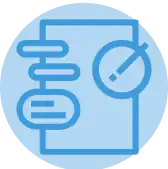
The top sections on a fashion designer CV
- Highlight your Design Portfolio showcasing your creative works, as this is the cornerstone of a designer's expertise.
- Detail your Fashion Education and Qualifications to establish your foundation in fashion theory and practice.
- Outline Relevant Work Experience to display your history of practical involvement in the industry.
- Include a List of Fashion Shows and Events to demonstrate your active participation and networking in the field.
- Show any Fashion Awards and Recognitions to underline your talent and accomplishments recognised by the industry.
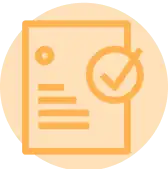
What recruiters value on your CV:
- Highlight your design philosophy and aesthetic, as this showcases your personal style and what sets you apart from other fashion designers.
- Include a portfolio link or QR code, so potential employers can easily view your collections and past work, demonstrating your range and creativity.
- Detail your experience with fashion shows, including involvement in planning, coordinating, or presenting collections, as hands-on experience is invaluable in the fashion industry.
- Emphasise your proficiency with design software and technologies such as Adobe Creative Suite, CAD, and 3D modelling, as technical skills are increasingly important in fashion design.
- Outline any collaborations with fashion brands, artists, or designers, which can highlight your teamwork skills and connectivity within the fashion community.
Recommended reads:
How to present your contact details and job keywords in your fashion designer CV header
Located at the top of your fashion designer CV, the header presents recruiters with your key personal information, headline, and professional photo. When creating your CV header, include your:
- Contact details - avoid listing your work email or telephone number and, also, email addresses that sound unprofessional (e.g. koolKittyCat$3@gmail.com is definitely a big no);
- Headline - it should be relevant, concise, and specific to the role you're applying for, integrating keywords and action verbs;
- Photo - instead of including a photograph from your family reunion, select one that shows you in a more professional light. It's also good to note that in some countries (e.g. the UK and US), it's best to avoid photos on your CV as they may serve as bias.
What do other industry professionals include in their CV header? Make sure to check out the next bit of your guide to see real-life examples:

Examples of good CV headlines for fashion designer:
- Creative Director | Women's Haute Couture Specialist | M.A. in Fashion Design | 15+ Years' Expertise
- Head Pattern Designer | Menswear Innovation | Textile Technology Graduate | 10 Years' Industry Leadership
- Lead Accessory Designer | Luxury Leather Goods | BA Hons Fashion Design | 5 Years’ Creative Vision
- Senior Fashion Illustrator | Digital Design Prodigy | Adobe Suite Expert | 8-Year Industry Veteran
- Junior Apparel Designer | Ethical Fashion Advocate | BA Fashion Design | Emerging Talent 2 Years' Exp.
- Fashion Product Developer | Sportswear Enthusiast | MA Fashion Merchandising | 7 Years’ Strategic Innovation
Catching recruiters' attention with your fashion designer CV summary or objective
Located closer to the top of your CV, both the summary and objective are no more than five sentences long and serve as an introduction to your experience. What is more, you could use either to entice recruiters to read on. Select the:
- Summary, if you happen to have plenty of relevant experience. Feature your most impressive accomplishments and up to three skills that are relevant to the job you're applying for;
- Objective, if you're just starting your career off. Provide your career goals and answer how you see the role you are applying for will match your professional growth.
Judging which one you need to add to your fashion designer CV may at times seem difficult. That’s why you need to check out how professionals, with similar to your experience, have written their summary or objective, in the examples below:

CV summaries for a fashion designer job:
- Dynamic Fashion Designer with 8 years of experience, specialising in women's haute couture. Exceptional skills in pattern making, draping, and textile selection, with a portfolio that includes design awards from Paris Fashion Weeks. Known for delivering sophisticated and innovative designs that resonate with international clientele.
- Menswear Designer with a decade of experience in the fast-paced New York fashion scene. Holds an impressive record in leading design teams that revitalised heritage brands. Skilled in CAD, trend forecasting, and sustainable fabric sourcing, with a signature aesthetic showcased in GQ and Vogue.
- Seasoned Graphic Designer pivoting into Fashion Design, bringing 5 years of creative expertise from a top London agency. Proven mastery of digital design tools, a keen eye for aesthetics, and an understanding of consumer psychology. Driven to blend visual storytelling with apparel to captivate the contemporary market.
- Innovative Interior Designer transitioning to Fashion, offering a fresh perspective from a 7-year career designing high-end living spaces in Milan. Strengths include a detailed understanding of textures and materials, combined with a flair for colour theory and spatial design, and a desire to make a mark in wearable art.
- A recent Fashion Design graduate with a first-class honours degree from Central Saint Martins, eager to apply theoretical knowledge and creative passion to practical design work. Ambitious about exploring avant-garde techniques and committed to contributing fresh ideas in a dynamic team environment.
- Highly motivated individual with no professional fashion experience but a lifelong passion for following and documenting global style trends. Enthusiastic about gaining hands-on knowledge in the fashion industry, with a dedication to learning and excelling in pattern cutting, styling, and the complete garment construction process.
How to meet job requirements with your fashion designer CV experience
We've now reached the essence of your actual CV - your experience section. This is the space where you can list your career roles and on-the-job successes. Many candidates tend to underestimate just how much time and effort they should put into writing this CV section. Your experience shouldn't be a random list of your responsibilities, but instead:
- Match the job description with your skills, values, and accomplishments;
- Start each bullet with a strong action verb, followed up with one key skill and your outcome of applying this skill;
- Spotlight parts of your career history that are relevant to the job you're applying for.
Before we move on, make sure to check out some professional CV experience sections.

Best practices for your CV's work experience section
- Designed an original autumn/winter collection which was presented at London Fashion Week, receiving accolades for innovative fabric use and sustainability.
- Collaborated closely with fabric suppliers to ensure the highest quality materials were used, resulting in a 20% increase in product longevity.
- Developed a streamlined design process to improve efficiency, cutting lead times from concept to runway by 30% without sacrificing detail or craftsmanship.
- Managed a team of junior designers, pattern makers, and seamstresses, fostering a collaborative environment that encouraged creativity and skill development.
- Used advanced draping and pattern cutting techniques to create flattering silhouettes, which became the distinctive feature of our Spring/Summer 2021 collection.
- Implemented eco-friendly design practices, successfully launching a line of upcycled garments that reduced fabric waste by 25%.
- Oversaw the selection of trims and accessories for collections, paying attention to the minutiae that distinguished the brand in a competitive market.
- Led successful negotiations with manufacturers to ensure products were produced to the highest standard, within budget, enhancing brand reputation for quality.
- Regularly analysed fashion trends and forecasted future directions, integrating them seamlessly into designs that resonated with our target market.
- Led a design team for Gucci's 2020 Summer collection, enhancing brand recognition by incorporating sustainable materials in 70% of the pieces.
- Spearheaded the redesign of women's haute couture line, resulting in a 25% increase in sales compared to the previous fiscal year.
- Negotiated collaborations with influential fashion influencers, increasing social media engagement and brand awareness by 40%.
- Developed a new accessory line for Louis Vuitton, which expanded the company's product portfolio and accounted for 15% of accessory sales in its first year.
- Implemented a customer feedback loop to adjust upcoming designs, leading to a 10% decrease in product returns due to fit issues.
- Collaborated with marketing teams to conceptualize and execute highly successful seasonal campaigns that boosted web traffic by 30%.
- Devised and implemented a streamlined prototyping process at Versace, reducing the lead time for sample development by 20% without compromising quality.
- Coordinated with cross-functional teams to produce a limited-edition menswear line, contributing to a 22% rise in quarterly revenue.
- Hosted a series of design workshops for junior designers, boosting department productivity and innovation.
- Redesigned Prada's casual wear portfolio, which increased the product line's market share by 18% within two years.
- Initiated a fabric innovation program that resulted in a 15% reduction in material costs while maintaining product quality standards.
- Optimized the supply chain process by partnering with ethical suppliers, increasing overall sustainability ratings by 30%.
- Revitalized Burberry's seasonal collections by introducing cutting-edge fabric technology, which attracted a younger demographic and improved sales by 20%.
- Conducted market research to analyze consumer trends and translated findings into design elements that were incorporated into the next two seasons' lines.
- Collaborated with production teams to ensure design integrity was maintained from concept to final product, leading to a 95% approval rate from first-line quality control.
- Introduced an innovative digital design workflow using 3D design software at H&M, cutting the sample creation timeline by 35%.
- Leading a team in the creation of H&M's eco-conscious line, aimed at reducing the company's carbon footprint by 20% within the launch year through the use of recycled materials.
- Managing collaboration with up-and-coming artists to create a unique 'Artist Capsule Collection,' anticipated to drive a 25% growth in online sales.
- Curated a vintage-inspired line for Calvin Klein that tapped into the retro trend, resulting in a 12% increase in customer base among millennials.
- Leveraged analytics to refine fit and sizing, reducing exchange rates by 18% due to improved customer satisfaction with garment fit.
- Mentored a team of assistant designers, enhancing their skillsets and enabling them to take on more complex projects within the year.
- Played a pivotal role in launching Zara's fast fashion protocol, which cut down design-to-store time to 2 weeks, boosting the company's ability to stay ahead of trends.
- Designed over 150 unique garments each year, which contributed significantly to maintaining high turnover rates and a fresh inventory at Zara stores.
- Implemented a cost-saving material utilization plan that saved the company an average of $100,000 annually on textile waste.
- Orchestrated the fusion of traditional and modern designs for Chanel's resort collection, which was critically acclaimed and led to a 30% increase in sales for the season.
- Conducted extensive fabric research that allowed the brand to pioneer the use of a new sustainable silk-alternative, reducing environmental impact.
- Partnered with global artisans to incorporate authentic traditional craftsmanship into high-fashion pieces, boosting cultural appreciation and brand value.
- Developed and launched Tommy Hilfiger's first line of wearable technology clothing, contributing to a 15% increase in brand engagement from tech-savvy consumers.
- Oversaw the design process from concept to runway for three consecutive seasons, receiving the 'Most Innovative Collection' award from Vogue.
- Implemented a cross-department communication system that enhanced efficiency in the design-to-manufacturing process, shortening product rollout timelines by 10%.
What to add in your fashion designer CV experience section with no professional experience
If you don't have the standard nine-to-five professional experience, yet are still keen on applying for the job, here's what you can do:
- List any internships, part-time roles, volunteer experience, or basically any work you've done that meets the job requirements and is in the same industry;
- Showcase any project you've done in your free time (even if you completed them with family and friends) that will hint at your experience and skill set;
- Replace the standard, CV experience section with a strengths or achievements one. This will help you spotlight your transferrable skills that apply to the role.
Recommended reads:

PRO TIP
Include examples of how you adapted to new tools, environments, or work cultures, showing your flexibility.
Mix and match hard and soft skills across your fashion designer CV
Your skill set play an equally valid role as your experience to your application. That is because recruiters are looking for both:
- hard skills or your aptitude in applying particular technologies
- soft skills or your ability to work in a team using your personal skills, e.g. leadership, time management, etc.
Are you wondering how you should include both hard and soft skills across your fashion designer CV? Use the:
- skills section to list between ten and twelve technologies that are part of the job requirement (and that you're capable to use);
- strengths and achievements section to detail how you've used particular hard and soft skills that led to great results for you at work;
- summary or objective to spotlight up to three skills that are crucial for the role and how they've helped you optimise your work processes.
One final note - when writing about the skills you have, make sure to match them exactly as they are written in the job ad. Take this precautionary measure to ensure your CV passes the Applicant Tracker System (ATS) assessment.
Top skills for your fashion designer CV:
Sketching
Pattern Cutting
Sewing
Textile Knowledge
Fashion Illustration
Technical Drawing
Computer-Aided Design (CAD)
Knowledge of Fashion History
Tailoring
Garment Construction
Creativity
Visualisation
Communication
Attention to Detail
Teamwork
Time Management
Flexibility
Trend Forecasting
Decision Making
Problem Solving

PRO TIP
If you have received professional endorsements or recommendations for certain skills, especially on platforms like LinkedIn, mention these to add credibility.
Education and more professional qualifications to include in your fashion designer CV
If you want to showcase to recruiters that you're further qualified for the role, ensure you've included your relevant university diplomas. Within your education section:
- Describe your degree with your university name(-s) and start-graduation dates;
- List any awards you've received, if you deem they would be impressive or are relevant to the industry;
- Include your projects and publications, if you need to further showcase how you've used your technical know-how;
- Avoid listing your A-level marks, as your potential employers care to learn more about your university background.
Apart from your higher education, ensure that you've curated your relevant certificates or courses by listing the:
- name of the certificate or course;
- name of the institution within which you received your training;
- the date(-s) when you obtained your accreditation.
In the next section, discover some of the most relevant certificates for your fashion designer CV:

PRO TIP
Order your skills based on the relevance to the role you're applying for, ensuring the most pertinent skills catch the employer's attention first.
Recommended reads:
Key takeaways
Here are five things you need to remember about writing your fashion designer CV for success:
- Sort your experience based on the reverse chronological order, starting with your most recent career items, to showcase how you've grown your career;
- Include within your CV header your relevant contact details, a headline that could spotlight your unique value, and a photo - if you're applying for roles outside the UK or US;
- Decide to use the CV summary, if you happen to have more professional experience, and an objective, if you want to showcase your career goals;
- Within the experience section, write your bullets using action verbs, skills, and success, instead of just merely listing your on-the-job responsibilities;
- Prove your technical skills, using your education and certificates, and your soft skills, with your achievements and strengths sections.
